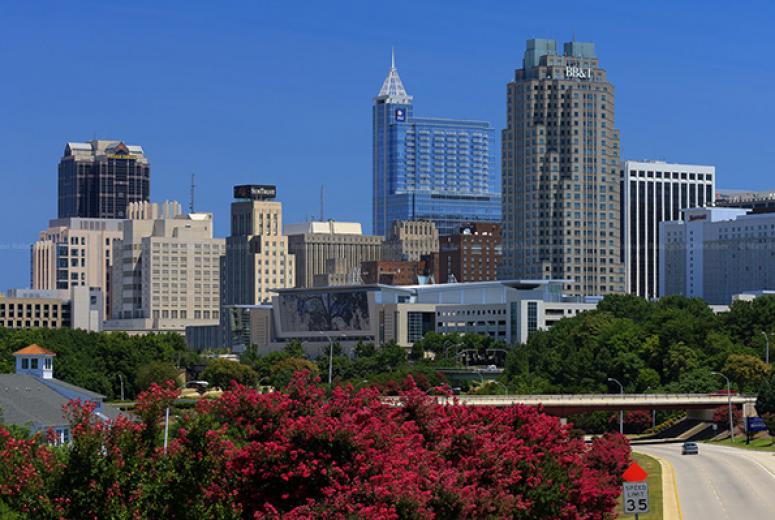1 4
1 4
.
Raleigh’s office vacancy has fallen steadily due to employment growth. Chang notes that 27,000 new jobs are expected in 2017, up from 23,000 in 2016. Additionally, rents are growing by 2.5 percent due to demand generated by employer growth throughout the Raleigh-Durham-Chapel Hill Research Triangle, providing a good balance relative to other markets tracked.
According to a Colliers International’s fourth quarter 2016 report, vacancy in the Research Triangle dropped to 7.9 percent, as the area absorbed 1.3 million sq. ft. of space during the previous 12 months, and vacancy in the Central Business District (CBD) at year-end was even lower, at 5.0 percent. Tight vacancy resulted in a 14.1 percent year-over-year spike in asking rents, to $27.10 per sq. ft. in the CBD and a 3.00 percent spike, overall to $21.51 per sq. ft.
Investment sales volume in the market rose 8.0 percent, according to Marcus & Millichap, with investors targeting class-B buildings due to the lack of availability of premium assets. This resulted in a 5.0 percent drop in average price, to $135 per sq. ft.
Steady leasing activity, rising rental rates and growing demand from technology tenants reaffirmed the strength of the Portland office market during the first quarter of 2017. With new product deliveries and a large office space user exiting the city, the market experienced negative net absorption of 74,977 sq. ft. and a slight uptick in overall vacancy from 8.1 percent to 8.2 percent, according to a Kidder Mathews’s first quarter 2017 market report. That followed a year when the city saw positive absorption of nearly 1.4 million sq. ft. At the end of the first quarter 2017, vacancy average 10.1 percent in the CBD and 7.3 percent in suburban sub-markets. However, vacancy in the Pearl District/Chinatown sub-market, which is popular with tech firms, was just 6.6 percent and will continue to tighten, according to Kidder Mathews.
A Colliers report noted that while office development in 2016 set a record, with more than 1 million sq. ft. in deliveries of new and adapted space, pre-leasing levels increased. According to the Kidder Mathews report, of the 7.33 million sq. ft. currently under construction, 55 percent is pre-leased.
“Portland is unique in that it is the most affordable area on the West Coast, and people want to live there,” Chang says. Numerous tech companies have opened offices in Portland to take advantage of the city’s young talent pool, he notes. As a result, 31,000 jobs were created in 2016.
Additionally, real estate costs in the city are also attractive, he says, noting that the average asking rent in Portland is $25 per sq. ft., compared to $60 per sq. ft. in San Francisco and $50 per sq. ft. in San Jose.
The Colliers report noted that total 2016 investment sales volume for the Portland metro areas totaled about $1 billion. Kidder Mathews reported that the average price per sq. ft. climbed to $252.
For similar reasons, tech companies are beginning to migrate to Oakland and the East Bay, where the cost of doing business is relatively cheaper compared to San Francisco and San Jose. Oakland has 4.4 million sq. ft. of creative office space that rents for about $40 per sq. ft. While Uber backed out of a plan to purchase the 330,000-sq.-ft. Uptown Station (formerly the old Sears building), a half dozen tech companies have moved or expanded to Oakland from San Francisco, including Autodesk, which has 8,000 employees in offices throughout the East Bay, according to a report from real estate services firm JLL.
A large pool of tech talent, which commutes to San Francisco or the Silicon Valley, already resides in Oakland, where the average apartment rent is $2,800 per month, compared to $3,624 per month in San Francisco, according to a third quarter 2016 Kidder Mathews report.
Boston has supply/demand dynamics that support rent growth, according to Chang, and the local economy is outperforming the nation. A first quarter 2017 JLL report noted that Boston recorded the largest decline in unemployment of all U.S. major metro markets in 2016, with 50,000 jobs created. Demand for space advanced across the market, and rents continued on an upward trend, pointing to another solid year for the greater Boston area.
After a record 8 million sq. ft. of space was absorbed since 2014, occupancy gains dropped slightly in the first quarter, but vacancy held steady at 13.9 percent. Lack of available space in Cambridge and the Seaport sub-markets, however, fueled absorption in adjacent areas and renewed leasing momentum in the inner suburbs, pushing overall market rents up 3.0 quarter-over-quarter.
There is about 3.1 million sq. ft. of new office product under construction in the Boston region, but just 1.6 million sq. ft. will be delivered this year, which is less than half of the new supply absorbed last year, the report noted.
Investment sales volume in the greater Boston area totaled nearly $16.1 billion in 2016, according to NGKF. A CBRE report noted that foreign and domestic capital sources competed fiercely for high quality urban office assets in Boston and Cambridge.

